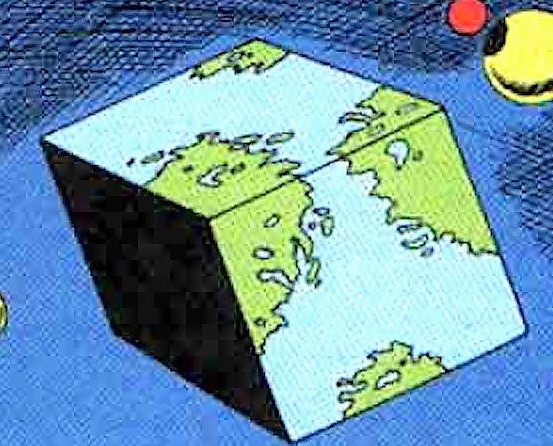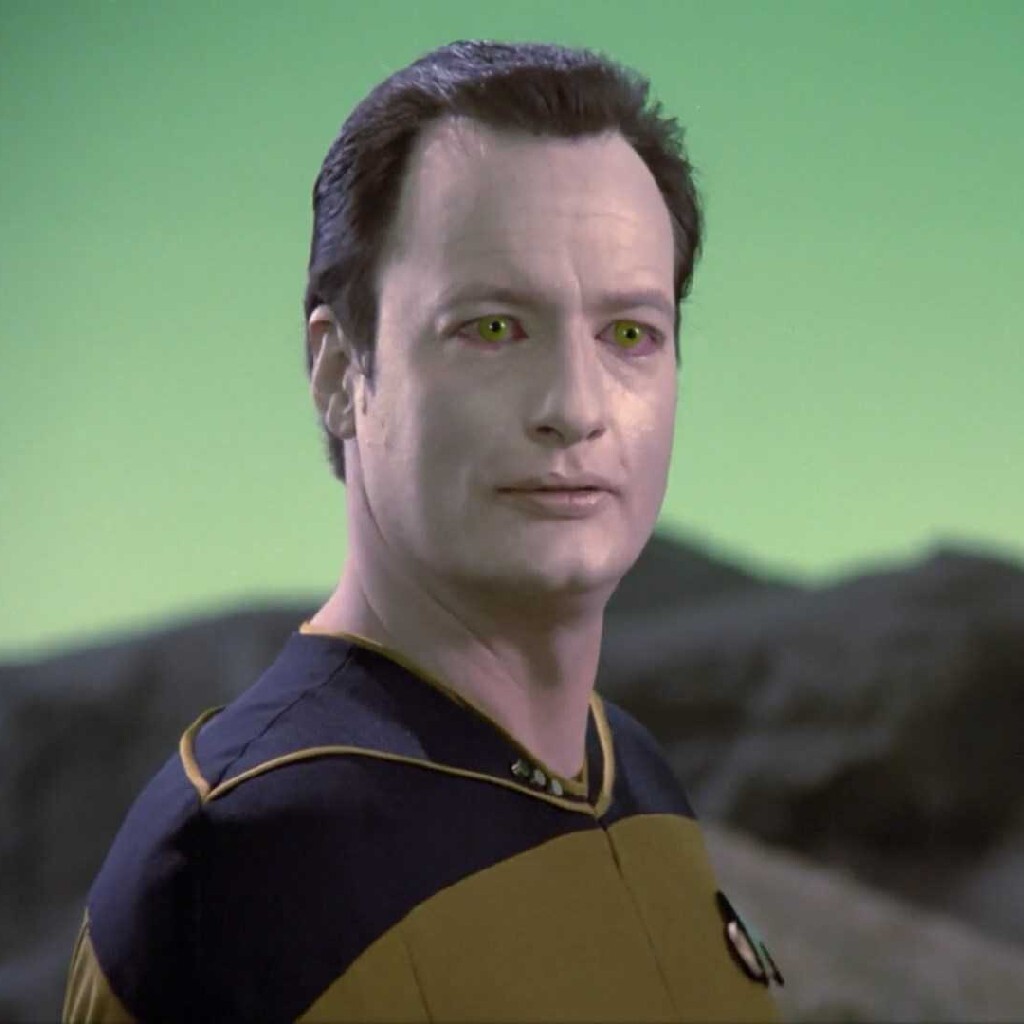For me it is the fact that our blood contains iron. I earlier used to believe the word stood for some ‘organic element’ since I couldn’t accept we had metal flowing through our supposed carbon-based bodies, till I realized that is where the taste and smell of blood comes from.
A day on Venus is longer than a year on Venus. One day takes 243 Earth days, while a year takes 225.
Maybe it’s not “well known”, but still interesting in my opinion.
I mentioned this one to my friends the other day and it took so much convincing before they actually believed me! Definitely an interesting one. Venus also spins the opposite direction to all the other planets in the solar system, meaning the sun rises in the west and sets in the east.
I get people telling me “no, that’s impossible” every time I mention this fact.
“Search your feelings, you know it to be true”
Wouldn’t spinning in the opposite direction indicate that it’s axial tilt is flipped or something?
The leading theory is a moon sized object hit it with enough force to spin it backwards.
The energy used to reverse the existing motion might explain why it’s so slow
Ok hold up so the way I’m understanding this is that its tilt (day) is slower than it’s rotation around the sun (year). Is that right or am I way off?
Yep, and as a result, the ‘movement’ of the sun across the Venusian sky during a day seems to change direction (I think?)
You’re close. Not the tilt of its axis, but its rotation around its axis (day) is slower than its rotation around the sun (year).
Earth’s axis is tilted at about 23 degrees, which causes the seasons. Venus, by contrast, is tilted only about 2.6 degrees, and thus basically doesn’t have seasons in a comparable way.
Earth’s axis does very slowly wobble around (precession). Over long enough time scales, this affects the seasons, and it means the North Star has not always been aligned with Earth’s North - once, North pointed at a patch of black sky and the North Star was just another star appearing to rotate around that arbitrary point.
I’d imagine Venus’s axis might also wobble at least somewhat, but I haven’t actually looked into this at all.
Thinking about this sent me down a rabbit hole because the day and year lengths are so extremely close to each other, and Venus rotates around its axis clockwise (unlike the other planets) while spinning around the sun clockwise, and its tilt is so slight… so as it spins around the sun, it rotates just enough to keep one side facing the sun almost all the time. I ended up googling whether it was tidally locked, like the moon is to Earth (such that we only ever see one side and it never changes) - and apparently it would be, but its atmosphere is so wild that it prevents tidal locking. But it almost is. It kinda has a dark side, and a light side, like the moon, but there’s just enough mismatch between the yearly rotation the axial rotation that the side facing the sun changes slowly. This is the first article I found.
From that article, it seems like the daylight hours you’d experience standing on the surface of Venus would be 117 Earth days of light, before it got dark again. So the sun would rise, and then you’d have about half a Venus year (aka about half a Venus day, too) of daylight before you’d see night again. And then it’d be night for the rest of the year. But still scorching hot because atmosphere.
Anyway this is blowing my mind a bit. I feel like I should have known this - I used to be obsessed with astronomy when I was little. Maybe I knew it once and forgot. I don’t know. But dayum. Planets are cool.
Yeah the Venus makes a lap around the sun in less time than it does a rotation around itself relative to said sun’s position in its sky.
I’ve seen this fact somewhere before, but I still am unable to grasp it in my mind
Short: It completes a full 360° of the sun before the planet itself does a full 360° spin.
A few sentences longer:
In planet Earth human terms, we have defined one day as “how long it takes the planet to do a full 360 degree rotation”. Example: You spin a basketball on your finger and it does one full rotation.A year to us is “how long it takes the planet to go around the sun”. Example: You hold a basketball out in front of you and you do one full rotation.
Now, to confuse people further, read about the difference between a solar day and a sidereal day.
Not exactly bizarre, but it’s fun to learn that the delicious fragrance of shrimps and crabs when cooked comes from chitin, and chitin is also why sautéed mushrooms smell/taste like shrimps.
And since fungi are mostly chitin, plants have evolved defenses against fungi by producing enzymes that destroy chitin, which is how some plants eventually evolved the ability to digest insects.
EDIT: a previous version of this post mistakenly confused chitin with keratin (which our fingernails are made of). Thanks to sndrtj for the correction!
There are only 24 episodes of the initial run of The Jetsons and only 25 of Scooby Doo. They got aired as reruns for decades before more episodes were made. There are only 15 episodes of Mr. Bean.
This one startled me.

Planets and stars and galaxies are there. You can see them because they’re right over there. Like, the moon is a big fucking rock flying around the earth. Jupiter is even bigger. I see it through a telescope and think “wow that’s pretty,” but every once in a while I let it hit me that I’m looking at an unimaginably large ball of gas, and it’s, like, over there. Same as the building across the street, just a bit farther.
The stars, too. Bit farther than Jupiter, even, but they’re right there. I can point at one and say “look at that pretty star” and right now, a long distance away, it’s just a giant ball of plasma and our sun is just another point of light in its sky. And then I think about if there’s life around those stars, and if our star captivates Albireoans the same way their star captivates me.
And then I think about those distant galaxies, the ones we send multi-billion dollar telescopes up to space to take pictures of. It’s over there too, just a bit farther than any of the balls of plasma visible to our eyes. Do the people living in those galaxies point their telescopes at us and marvel at how distant we are? Do they point their telescopes in the opposite direction and see galaxies another universe away from us? Are there infinite distant galaxies?
Anyway I should get back to work so I can make rent this month
If I point my finger at one of those galaxies, there’s more gas and shit between us within a hundred miles of me than there is in the rest of the space between us combined
What’s even more fascinating is that most of the stars we see in the sky are afterimages of primitive stars that died out long ago yet they shine as bright as the stars alive today
That doesn’t seem right. The galaxy is only 100,000 light years across (give or take) and the life span of stars is measured in billions of years.
Most of the stars we see are in our galaxy, so at most, we are seeing them as they were 100,000 years ago, which means that the vast majority of them will still be around, and looking much the same as they did 100,000 years ago.
I seem to have made a mistake then. Thank you for correcting it.
Thinking about it further, if we’re talking about stars that we can see with telescopes, Hubble, James Webb etc, then you’re on the money. Stars in remote galaxies far outnumber the ones in our galaxy and show us glimpses of the early stages of the universe. And many of those stars are long gone
Not too sure where you got that number from. From what I can find, the radius of the observable universe is estimated to be about 46.5 billion light-years.
Edit: I see now that you are talking Galaxy. That’s different.
The original comment was about stars we can see in the sky, so I was assuming naked eye
deleted by creator
I mean, you may think it’s a long way down the road to the chemist’s, but that’s just peanuts to space.
In the same vein, I like to remind myself that every field in physics is literally happening all around me, right now, and it always has been, in fact, I’ve never seen anything without these invisible fields in it and for some reason, that really makes me super aware of our place in the order of magnitudes.
It’s wild we can see so much further down than up.
First time I saw Jupiter through a telescope I got hit hard by the feeling: “Oh shit, that giant monster is real”.
Samesies. You aren’t alone. We have a support group.
People don’t realize how crazy it is to have a moon orbiting earth
A moon isn’t that strange, our moon is.
First, it is massive compared to Earth. The mass of the Moon is so large that it messed with definitions of planets and plutinos.
Second, the Moon’s size and distance from Earth is a near match for the Sun’s, which is really rare.
And for a strange fact, the Moon is about as reflective as worn asphalt. The Moon looks white in photos of just itself, but it is a dark grey when in photos with Earth.
“Just a bit farther” is quite the understatement!
“I mean, you may think it’s a long way down the road to the chemist’s, but that’s just peanuts to space.”
Speaking as someone who grew up in the 1980s…
Micro-SD cards almost don’t make sense to me. I’m not saying I don’t believe in them, because of course I have a few of them. Obviously they exist and they work. But. They’re the size of a fingernail and can hold billions of characters of data. I uwve a camera that ive put a 128 GB microSD card in. A quick tap on the calculator tells me that’s over 91,000 3.5" floppy disks. Assuming they’re 3mm thick, that’s a stack of disks 273 meters tall. But this card is so tiny that I have to be careful not to lose it.
How about the new 2Tb m.2 drives? Not only vastly larger yet still, transfer speeds are also insane. I once had a computer with a 20Mb hard drive, current drives transfer 600-1200mb per second.
Not so impressive, of course its faster when its smaller. The data have to travel shorter.
Jk, it is damn impressive!
Actually, that’s true! It’s not significant enough to affect the throughput directly, but when you transmit data on parallel leads, they have to be roughly the same length in order to keep the signals synchronised with the time frames when they are received. Otherwise part of the data might not arrive in time. The higher the throughput (and shorter the frames), the greater the leads’ lengths affect the timing. This is why you often see long squiggly leads on circuit boards - they extend the shorter leads to roughly the same lengths.
Eh, parallel hasn’t been used for a while already. SATA literally means “Serial ATA” and no longer uses parallel connections. I haven’t seen parlallel connectors since like a decade or so
I wasn’t talking about connectors, I was talking about circuits inside the devices. Even if something is as simple as a clock and a data signal travelling in parallel, timing is still an important factor.
I saw 1tb microsd cards for sale at the shops the other day and had a bit of a ‘what the fuck…’ moment
I remember my parents talking about some thing or other in star trek that would be impossible because you’d need “terabytes of storage, and that’s probably not possible”. And now you can go buy 1 tb of storage and lose it in your couch cushions.
Poor Keanu Reaves gave up his childhood memories in Johnny Mnemonic to store something like 100GB of data in his brain. I don’t remember the Star Trek storage callout cause they were generally pretty good about just fabricating their own units for stuff (future sci-fi writers should take note, it’s always easier to make up units then deal with pedantic people on the internet).
I lost a 1tb flash drive with ventoy and a bunch of files and I’m still mad, but I had a backup lol
The latest SDUC standard allows for up to 128 TB.
It gets better. The size of the SD card isn’t the storage area. Look carefully at the back of an SD card and you should see how a tiny square area in the middle is a bit ‘thicker’ than the rest; that’s the actual chip, that tiny bump!
SD cards make sense to me. Hard Drives… Now there is some spooky technology.
The reader head on a hard drive changes direction so fast, that it experiences accelerations like that of a bullet being fired, hundreds of times a second.
The “Fly height” or distance a reader floats above the platter is so tiny, that it would crash into a thumbprint.
The actual magnetic media that stores your data is a layer of iron a few atoms thick deposited on to a ceramic or glass platter, with a single atom layer of a protective metal coating (typically rhodium) in top of it.
Despite these incredible tolerances, they damn things are dirt cheap, and surprisingly reliable.
And the price of that 128 gb sd card? €10-15, 512 gb cards are even crazier right now at like €35 a piece, that’s €0,068 per gigabyte
Also fun, they rely on quantum mechanics.
Individual “bits” on a SD card are electron buckets that are either “full” (they have an electron) or not. 8 bits to a byte ~1 trillion bytes to a terabyte.
What’s a floppy disk?
That’s just another name for the save icon.
I really get the feeling that this question isn’t being asked seriously but here goes.
Floppy disks are an older removable storage format for a computer. The media inside the disks was flexible like a piece of paper, hence the term “floppy”. There were three different common sizes, there was an 8", a 5.25", and a 3.5". The 8" and 5.25" had the flexible media in a sort of heavy fabric and plastic sheath that was itself flexible, amd the 3.5" disks had a hard plastic cover on the outside, with a sliding metal door, and some people erroneously called these “hard disks”.
I’ve got a 1tb microsd and it’s crazy to see the difference between a 60MB harddisk and it
Let’s stick with the iron in your hemoglobin for some more weirdness. The body knows iron is hard to uptake, so when you bleed a lot under your skin and get a bruise, the body re-uptakes everything it can. Those color changes as the bruise goes away is part of the synthesis of compounds to get the good stuff back into the body, and send the rest away as waste.
In the other direction, coronaviruses can denature the iron from your hemoglobin. So some covid patients end up with terrible oxygen levels because the virus is dumping iron product in the blood, no longer able to take in oxygen. I am a paramedic and didn’t believe this second one either, but on researching it explained to me why these patients were having so much trouble breathing on low concentration oxygen… the oxygen was there, but the transport system had lost the ability to carry it.
The body knows iron is hard to uptake
I had to take iron supplements in the past because my periods were so bad that I would lose my vision and pass out from loss of blood.
I don’t have iron issues so I haven’t completely fact checked this, but I have read in various places that using cast iron skillets to cook with does add more iron to your foods to help supplement.
There are also iron “fish”, or fish shaped blocks of iron, that can be used while cooking which do the same thing!
Before using cast iron daily, when I donated blood my iron levels were regularly at the lowest allowable limit or sometimes too low to donate. Once I started cooking with cast iron, I started getting comments about how great my iron levels are every time I donate.
That is super interesting information and kind of makes sense with the seasoning involved.
But I recently learned you can get different enamel types that you don’t have to season.
I would think an enameled skillet would not provide any extra iron; the glass that the enamel is made of forms a barrier between the iron and everything else. That’s nice because you don’t have to worry about it rusting any more, but it also means no iron in your food.
Yeah, its like a trade off. I’m uneasy about having to season a pan for some reason. I’m pretty sure I have OCD and if I can’t clean a dish the way I clean my other dishes it bugs me to some extent.
Ah gotcha, I can understand how that might be a thing; cat iron is definitely something you treat differently than other dishes. There’s a whole fascinating level of nerdery to proper seasoning, but it’s definitely special cookware that doesn’t fit the usual patterns.
yeah, for some reason it gets to me that there is something left on the pan on purpose. My brain just wants me to scrub it all off.
You’ll just develop a new ocd about how sexy you can make your cast iron look. They’re the only dishes related thing I enjoy cleaning up.
lmao that’s definitely not how OCD works.
Please tell us more or other things!
Time relativity always boggles my brain, I accept the fact but I find crazy that if I strap my twin and his atomic clock to a rocket and send them out to the stratosphere at the speed of light, when they return he’ll be younger than me and his clock will be running behind mine. Crazy
It’s even crazier because you don’t need to reach the speed of light. It’ll happen in a smaller degree for any speed. Even in mundane conditions.
For example, if your twin spent four days in a 300km/h bullet train, for you it would be four days plus a second.
Usually this difference is negligible, but for satellites (that run at rather high speeds, for a lot of time, and require precision), if you don’t take time dilation into account they misbehave.
(For anyone wanting to mess with the maths, the formula is Δt’ = Δt / √[1 - v²/c²]. Δt = variation of time for the observer (you), Δt’ = variation of time for the moving entity (your twin), v = the moving entity’s speed, c = speed of light. Just make sure that “v” and “c” use the same units.)
I wonder how long it would have taken for us to figure out time dilation in Einstein hadn’t predicted it. I wonder if it would have taken until we observed it with satellites.
Without Einstein, I think that the discovery of time dilation would be delayed by only a few years. There were a lot of people working in theoretical physics already back then; someone else would inevitably dig through Lorentz’ and Poincaré’s papers, connect the dots, and say “waitaminute time might be relative”. From that, time dilation is a consequence.
In special I wouldn’t doubt that Max Planck would discover it.
I’m saying that because, in both science and engineering, often you see almost concurrent discoveries or developments of the same thing, because the “spirit of a time” makes people look at that aspect of reality or that challenge and work with it. The discovery of helium and the development of aeroplanes are examples of that.
IIRC the orbit of Mercure doesn’t work with Newton Model, and astronomers were predicted the discovery of Vulcain a small planet between Mercure and the Sun. So a new model had to be invented since Vulcain couldn’t be found.
We would have definitely figured it out once we built GPS, since you need to account for relativistic effects there.
Yes I knew about that and I’m glad that doesn’t make it crazier for me, instead it makes it easier to accept. If it were something that happened only after hitting some arbitrary speed value I’d be a lot more mentally damaged
To be fair the only ones that don’t get mentally damaged at all with this stuff are theoretical physicists. After all being crazy makes you immune to further madness.
deleted by creator
Also the idea that light is both a particle and a wave always messed with my head because I wanted to know why does it decide to change and when? And the answer is that light is always a particle and always a wave at the exact same time.
It is a wave particle.
And it is possible from light alone to build both an electron and a positron as demonstrated in a 1999 laser science experiment in New York.
I usually interpret this as behaviour: photons are not “particles” or “waves”, photons are photons. They just behave as waves and as particles, depending on how you’re looking at them.
Note that even things with a resting mass (like you or me) are like this, too. It’s just that, as the mass increases, the wave behaviour becomes negligible.
deleted by creator
This doesn’t make it any less crazy
The crazy thing is there are actually two double slit experiments, and that light can tell whether or not you are actively observing it or not, and decides whether or not to actually exist as a wave or particle.
I heard from someone I respect irl that these experiments were debatable, but I can’t personally hold an argument about it.
From what I understand, you are always travelling at the speed of light through space/time, but when you move at high speeds through space that shifts the proportion of your speed out of the time dimension. And a photon travels only through space, experiencing no time between the time it was emitted and the time it was absorbed. What I just can’t wrap my head around is the concept of travelling at some speed without involving the time dimension at all.
Probably one of the most memorable and pivotal moments in my life was when my college professor showed us the origins of relativity and how Einstein came to the conclusion that E = mc^2
It’s a proof that only took about 10 minutes to explain, and the mathematics really aren’t that difficult to understand by most people. The geniuses in the fact that Einstein started by explaining how calculating relative motion meant that time had to be a variable that could be different depending on who the observer was. This in itself is an incredible observation, but you can take this to the extent to literally prove that mass and energy are directly related to each other. It’s absolutely wild and one of the most sublime equations ever made.
Here’s something I just ran into looking stuff up for my comment: GN-z11 is one of the farthest galaxies we’ve ever seen. Thanks to the expansion of the universe, at a distance of over 30 billion light-years, it has to be moving away from us at over twice the speed of light.
What the fuck does that mean, temporally? Like, forget the speed of light, time dilation has to do with space and relative speeds. If I’m moving at near the speed of light relative to you, then my clock will physically tick more slowly. What happens if I’m moving over twice the speed of light? Is the real life GN-z11 in our reference frame moving backwards in time at over twice the rate we’re moving forward?
I can’t find any reference that says it’s moving away from us at twice the speed of light, which would violate Relativity. The fact that it is further away from us in light years than the age of the universe in years, is due to the fact that the space itself is expanding.
The thing is, it’s moving that fast because of the expansion of space. ≈30 billion light-years over ≈14 billion years equates to over twice the speed of light. Does that mean there’s no crazy relativistic time dilation, and time is moving normally for them in our frame of reference, since they aren’t physically moving, it’s space that’s expanding? That’s just as wild to my brain
Relativity only applies to local reference frames and not to the recession rates of cosmologically distant objects.
The part that I understand in the intellectual sense, because I know or at least used to know how it follows from the math, but which just doesn’t feel like it should be the case, is the whole “relativity of simultaneity” aspect of it. That there isn’t an objectively true order in which events happen in, if the events in question aren’t linked by cause and effect. That is to say, it is possible for one person to see an event A happen before another event B, a second person to see the two happen at exactly the same time, and a third to see event B happen first and then event A, and for all three of them to be equally right. It just feels like, on some level, there ought to be one objectively true order to time, a single valid timeline that all events can be placed in relative to eachother, and for time not to work that way feels so absurd as to not even be able to articulate why the idea feels wrong.
deleted by creator
I see another veritassium fan here maybe?
I wish we could test this out with only simple apparatus. Unfortunately the common people do not have access to satellites or nonstop bullet trains.
We can and do. GPS satellites need to be regularly calibrated to Earth clock signals or they’ll start to drift their calibration by meters per day.
deleted by creator
Please dont do that
There is about 8.1 billion people in the world. Assuming romantic cliches to be true and that we all have exactly one soulmate out there, we would have a very hard time sifting them out. If you were to use exactly one second at meeting a person it would take you 257 years to meet everyone alive on earth at this moment, which due to human life span being significantly shorter and the influx of new people makes the task essentially impossible without a spoonful of luck. Moral of the story: If you believe you have found your soul mate, be extra kind to them today.
Queuing theory can have some fun surprises.
Suppose a small bank has only one teller. Customers take an average of 10 minutes to serve and they arrive at the rate of 5.8 per hour. With only one teller, customers will have to wait nearly five hours on average before they are served. If you add a second teller the average wait becomes 3 minutes.
Can you elaborate on the math here? (I believe you, I just want to understand the simulation parameters better).
Not OP, but this website should explain everything.
Thanks! This article really clears up a lot of the details that help the simulation make sense.
deleted by creator
Also, in this simulation are the customers arriving in equally spaced intervals or is random arrival time within the bounds assumed?
In the linked article they are arriving randomly. It takes 10 minutes per customer and they arrive every 10.3 minutes.
Aren’t they arriving slightly slower than can be served, according to these numbers:
If one customer takes 10 minutes to serve, you can serve 6 customers in an hour
and you get 5.8 customers every hour, which is less than 6
So you serve 6 customers, meaning you have a leftover capacity of 0.2 per hour or 1 extra customer every 5 hours
Maybe the numbers are switched over or I am misunderstanding something
Edit: nevermind, read the link in the thread and realised I treated the average as the actual serving time and I’m guessing that’s what makes it non intuitive. I’m still not entirely clear on how it works.
deleted by creator
They’re arriving slower than they can be processed. So the line shrinks slowly it there’s a line.
deleted by creator
Assume the bank opens up to a long line and it makes sense.
Intuitive way to see why is that 6.1 customers per hour would mean infinite waiting time (when it reaches a steady state)
Calcium is a metal. We have metal bones.
From Wikipedia on bones:
Bone matrix is 90 to 95% composed of elastic collagen fibers, also known as ossein,[5] and the remainder is ground substance.[6] The elasticity of collagen improves fracture resistance.[7] The matrix is hardened by the binding of inorganic mineral salt, calcium phosphate, in a chemical arrangement known as bone mineral, a form of calcium apatite.[9]
So the statement is a bit faulty, not only because of the relative low amount of calcium in our bones, but also because it appears as a mineral. We distinguish between salts and metals because of their chemical properties being quite different (solubility, reflectiveness, electrical conductivity, maleability and so on).
Edit: I do realize the point of the comment was not to be entirely factual, so if I am allowed as well I would say science is pretty metal.
We also distinguish between metals and non-metals by field of study. Ask an astronomer which elements are metals sometime.
How so? I thought they were mostly determined by their positions in the table of periodic elements.
Thanks for the reality injection!
The statement was glib but even the partial truth of it made me wonder when I first learned it.
Oh my… I refuse to accept this as reality
We’re all organically powered metal meat machines? 😭
In the same sense that we contain a massive volume of gas, because there is a lot of hydrogen in our bodies. Yes, hydrogen is a gas, and yes, there is a lot of it on our body. But it’s bound, so it doesn’t count.
It would be more accurate to call it stone than metal, because the calcium in our bones is also bound to other elements, which means it does not exhibit its usual metal characteristics.
The meat is suffused with more metal throughout it
Here is an alternative Piped link(s): https://piped.video/GggK9SjJpuQ
Piped is a privacy-respecting open-source alternative frontend to YouTube.
I’m open-source, check me out at GitHub.
By the sound mine make I would have thought free jazz.
They sure don’t feel metal.
Nigel?
That “I” am pretty much just the construct of electrons flying around my brain.
That you need to lay down K.O. for many hours every day, otherwise you get insane.
That we are always only 2min or so away from death, if we stopped breathing.
That everything I eat actually gets digested into mousse and bacteria are in my body, digest it and I get the elements into my blood.
That our world is so big, but you could also walk to China
Japanfrom the EU, if you had enough time. But also its crazy how huge our common trade routes are.That a weird minicomputer in my pocket can store 128GB of information, access a wireless network from across the whole planet, and can remember so much more than my brain
The sun could’ve gone nova 8 minutes ago and we wouldn’t know for another 20 seconds or so.
Interesting fact: the sun becomes 1 million tons lighter every second.
Diet specialists hate this trick.
It’s simply burning calories.
Lighter or brighter?
The ton is not a unit of brightness
You sure? The wacky system of units has a lot of different meanings for the word ton. Among others, it is a measure of power.
Is brightness ever measured in tons?
Yes.
Well, we’d know by now
I might be misremembering but I believe our sun can’t go nova, it’s too small. It will, however, expand and swallow the Earth towards the end of its life.
When exactly would that be? I gotta add it to my calendar.
Don’t worry, your calendar doesn’t go that far
The Sun is not a big enough star to ever go nova. Neither are any of our close neighbors. We’re pretty safe from that kind of disaster.
Earth is just gonna slowly cook to a cinder and probably get swallowed when the Sun starts expanding in a couple billion years.
Fine! Geez.
Space aliens could teleport in next to sun, fling a bunch of Star Trek red matter at it like Spock did to the Romulan star, destabilize the star, and cause a, I think it was a black hole? where the star was. And we wouldn’t know for 8-ish minutes.
Don’t know if it’s bizarre but I was shocked when I found out I’d been lied to my whole life… a leap year isn’t every 4 years.
So leap years happen when the year is divisible by 4, but not when the year is divisible by 100 but then they do again when the year is divisible by 400.
So the year 2000 is a perfect example of the exception to the exception. Divisible by 100 so no leap year, but divisible by 400 so leap year back on…
The mitochondria in all but your blood cells are a different species than us with their own separate DNA.
There’s about 25 blimps in the world, and only 40-50 pilots.
doesn’t really fit the thread, but i was surprised when i learned that the empire state building has a blimp docking station

They really thought blimps were gonna be a thing.
They should have been
this is super cool.
That looks like sea creatures mating
“Highlander” rules.
There can be ONLY one!

































